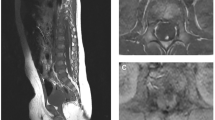Abstract
Background
In tethered cord syndrome due to filum terminale pathology, the surgical approach to achieve detethering of the spinal cord may vary. Traditionally, sectioning the filum through a laminectomy at the lumbosacral level is performed.
Method
A microsurgical technique at a higher level to approach the filum below the conus tip is performed. This allows for removal of the entire distal portion of the filum through a limited interlaminar approach and dural opening.
Conclusion
We propose a technique to transect the filum terminale below the conus tip and extract the distal filum by releasing it from its intradural attachments to minimize any remnants of the filum terminale.





Similar content being viewed by others
References
Sassack B, Carrier JD (2022) Anatomy, back, lumbar spine. In: StatPearls [Internet]. Treasure Island (FL): StatPearls Publishing; 2023 Jan–
De Vloo P, Monea AG, Sciot R, van Loon J, Van Calenbergh F (2016) The filum terminale: a cadaver study of anatomy, histology, and elastic properties. World Neurosurg 90:565-573.e1
Gao X, Du P, Xu J, Sun J, Ding W, Yang D-L (2022) Repair of cerebrospinal fluid leak during posterior thoracolumbar surgery using paraspinal muscle flap combined with fat graft. Front Surg 9:969954
Gardner WJ, Bell HS, Poolos PN, Dohn DF, Steinberg M (1977) Terminal ventriculostomy for syringomyelia. J Neurosurg 46(5):609–617
Hayashi T, Kimiwada T, Kohama M, Shirane R, Tominaga T (2018) Minimally invasive surgical approach to filum lipoma. Neurol Med Chir (Tokyo) 58(3):132–137
Kestle JRW (2012) Retethering after filum cutting. World Neurosurg 77(1):82
Klinge PM, McElroy A, Leary OP, Donahue JE, Mumford A, Brinker T, Gokaslan ZL (2022) Not just an anchor: the human filum terminale contains stretch sensitive and nociceptive nerve endings and responds to electrical stimulation with paraspinal muscle activation. Neurosurgery 91(4):618–624
Klinge PM, Srivastava V, McElroy A, Leary OP, Ahmed Z, Donahue JE, Brinker T, De Vloo P, Gokaslan ZL (2022) Diseased filum terminale as a cause of tethered cord syndrome in Ehlers-Danlos syndrome: histopathology, biomechanics, clinical presentation, and outcome of filum excision. World Neurosurg 162:e492–e502
Romagna A, Suchorska B, Schwartz C, Tonn J-C, Zausinger S (2013) Detethering of a congenital tethered cord in adult patients: an outcome analysis. Acta Neurochir (Wien) 155(5):793–800
Vassilyadi M, Tataryn Z, Merziotis M (2012) Retethering in children after sectioning of the filum terminale. Pediatr Neurosurg 48(6):335–341
Yong RL, Habrock-Bach T, Vaughan M, Kestle JR, Steinbok P (2011) Symptomatic retethering of the spinal cord after section of a tight filum terminale. Neurosurgery 68(6):1594–601 (discussion 1601-1602)
Author information
Authors and Affiliations
Corresponding author
Ethics declarations
Ethical approval
This article did not require IRB approval.
Informed consent
Due to its retrospective and deidentified nature, no patient identifiers were included.
Conflicts of interest
The authors declare no competing interests.
Additional information
Publisher's note
Springer Nature remains neutral with regard to jurisdictional claims in published maps and institutional affiliations.
10 Key Points
1. Tethered cord release classically involves sectioning the filum.
2. Retethering and adhesive arachnoiditis are significant concerns post-operatively.
3. Approaching the filum closer to the conus minimizes the remnant filum.
4. Resection of the filum can be done safely by detaching it from intradural attachments.
5. Positioning the proximal filum stump within the cauda nerve roots limits retethering.
6. Meticulous hemostasis is critical to avoid developing arachnoiditis.
7. Use of a diamond burr drill and monopolar electrocautery for the bone edges helps with hemostasis.
8. A local autologous fat graft technique is demonstrated which limits CSF leak rates.
9. Follow-up MRI at 6 months reveals no signs of retethering or arachnoiditis.
10. A limited interlaminar approach and small dural opening are sufficient to achieve the goals of the surgery.
Supplementary Information
Below is the link to the electronic supplementary material.
Supplementary file1 (MP4 178633 KB)
Rights and permissions
Springer Nature or its licensor (e.g. a society or other partner) holds exclusive rights to this article under a publishing agreement with the author(s) or other rightsholder(s); author self-archiving of the accepted manuscript version of this article is solely governed by the terms of such publishing agreement and applicable law.
About this article
Cite this article
Abdulrazeq, H., Shao, B., Sastry, R.A. et al. Microsurgical approach for resection of the filum terminale internum in tethered cord syndrome—a case demonstration of technical nuances and vignettes. Acta Neurochir 165, 3505–3509 (2023). https://doi.org/10.1007/s00701-023-05568-9
Received:
Accepted:
Published:
Issue Date:
DOI: https://doi.org/10.1007/s00701-023-05568-9




